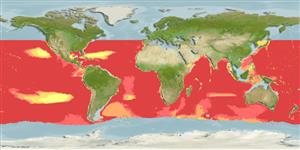Teleostei (teleosts) >
Myctophiformes (Lanternfishes) >
Myctophidae (Lanternfishes) > Lampanyctinae
Etymology: Ceratoscopelus: Greek, keras, -atos = horn + Greek, skopelos = a lantern fish (Ref. 45335).
More on author: Lütken.
Environment: milieu / climate zone / depth range / distribution range
Ecology
Marine; bathypelagic; oceanodromous (Ref. 51243); depth range 391 - 2056 m (Ref. 27311). Deep-water; 42°N - 65°S, 180°W - 180°E
Atlantic Ocean: 35°N (eastern limit) and 42°N (western limit) south to the Subtropical Convergence. Pacific Ocean: tropical and subtropical waters (Ref. 4066). Indian Ocean: 20°N-45°S (Ref. 4066). Reported to be common in southern Africa (Ref. 4066). South China Sea and East China Sea (Ref.74511).
Length at first maturity / Size / Weight / Age
Maturity: Lm ?, range 5 - ? cm
Max length : 10.2 cm TL male/unsexed; (Ref. 125989); max. published weight: 11.40 g (Ref. 125989)
Oceanic species found between 700 and 1,500 m during the day; between 20 and 200 m at night (Ref. 4775) with maximum abundance between 50 and 100 m (Ref. 47377). Size stratification with depth both day and night (Ref. 4775). Small juveniles (1.5-1.9 cm) are apparently non-migratory. Known to feed on zooplankton but appears to be adapted for occasional herbivory (Ref. 28809).
Life cycle and mating behavior
Maturities | Reproduction | Spawnings | Egg(s) | Fecundities | Larvae
Hulley, P.A., 1990. Myctophidae. p. 398-467. In J.C. Quero, J.C. Hureau, C. Karrer, A. Post and L. Saldanha (eds.) Check-list of the fishes of the eastern tropical Atlantic (CLOFETA). JNICT, Lisbon; SEI; Paris; and UNESCO, Paris. Vol. 1. (Ref. 4479)
IUCN Red List Status (Ref. 130435)
Threat to humans
Harmless
Human uses
Tools
Special reports
Download XML
Internet sources
Estimates based on models
Preferred temperature (Ref.
123201): 3 - 8.8, mean 5.5 °C (based on 1535 cells).
Phylogenetic diversity index (Ref.
82804): PD
50 = 0.6250 [Uniqueness, from 0.5 = low to 2.0 = high].
Bayesian length-weight: a=0.00794 (0.00484 - 0.01305), b=3.20 (3.06 - 3.34), in cm total length, based on LWR estimates for this species & (Sub)family-body (Ref.
93245).
Trophic level (Ref.
69278): 3.4 ±0.53 se; based on food items.
Resilience (Ref.
120179): High, minimum population doubling time less than 15 months (Preliminary K or Fecundity.).
Fishing Vulnerability (Ref.
59153): Low vulnerability (10 of 100).
